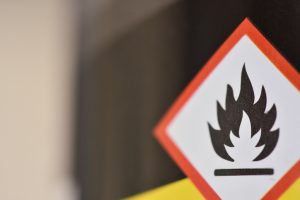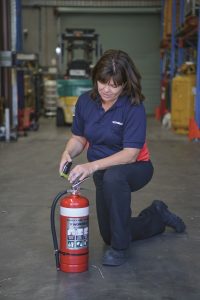In the line of fire
Fires on worksites aren’t unheard of, but do you know what to do in the event of an emergency? Wormald national manager Matt Sulley offers this update to safety in the face of fire.

Construction sites are busy environments where numerous trades and contractors work side-by-side, often with heavy, powerful equipment and vehicles.
There are also a number of hazards inherent to construction sites, including an increased risk of fire occurring as a result of daily activities, such as demolition and excavation works, welding, cutting, steel grinding and the application of torches in an environment where packaging, timber formwork and other materials are commonly found.
The Building Code of Australia (BCA) mandates that firefighting equipment must be available to assist construction workers and emergency services with putting out a fire as quickly as possible. It is the responsibility of the primary builder to ensure this occurs on all construction sites throughout the entirety of the project.
In a construction environment, compliance can be complex with each new work site likely to vary in size, location, lay out and environment. This can make fire safety particular challenging for the building industry.
To assist with achieving compliance in a range of settings, it is vital for builders to keep abreast of legal requirements, as well as recent developments in fire safety, both in terms of new regulation and next generation equipment and products.
Fire safety requirements in construction
Firefighting equipment such as portable fire extinguishers, fire hose reels and fire blankets form the first line of defence in a fire. A potential fire can often be controlled before it really takes hold, if the right fire equipment is close at hand.

Fire precautions in a building under construction must include at least one fire extinguisher on each storey to suit different fire types that are classified as Class A, Class B and Class C fires.
They are as follows:
- Class A (wood, paper, plastic)
- Class B (flammable and combustible liquids)
- Class C (flammable gases) fires and electrical fires
Fire protection equipment must remain adjacent to each required exit or temporary stairway or exit, at all times.
Once the building increases in size, so do the fire safety requirements. When a building under construction has reached an effective height of 12m, the required fire hydrants and fire reels as specified by the BCA must be operational and any required booster connections must be installed.
Further fire protection
Depending on the site, additional fire protection equipment may also be deemed appropriate, such as:
- Fire blankets.
- Advanced vehicle fire suppression systems designed to protect heavy mobile equipment from fire damage.
- Adaptable portable units which can be suited to a range of different fire scenarios.
- Specialist solutions for chemical fires and emergency equipment such as breathing apparatus for heavy industrial sites where fuel terminals and chemicals are used.
Differences in fire extinguishers
A fully functional fire extinguisher can mean the difference between a minor incident and a devastating full scale fire on a construction site, which is why it is absolutely crucial to ensure all fire extinguishers and fire hose reels are serviced every six months.
When it comes to portable fire extinguishers, there are important differences. The type of fire extinguisher required for a building site will depend on the class of fire and fire risk. For example, dry chemical powder (DCP) extinguishers are well suited for most fire types, including fires involving oil.
Different extinguisher types can be distinguished by a coloured band around the top of the cylinder, making identification quick and simple.
- ABE extinguishers are suitable for Class A, B and C fires, as well as those involving electrically energised equipment, and distinguished by a white band around the top of the cylinder.
- Foam fire extinguishers are suitable for Class A and B fires and these are marked with a blue band. Foam extinguishers work by covering a burning flammable liquid with a blanket of foam, cutting off the fire’s air supply and preventing the release of flammable vapours.
Fluorine Free Foam
Fluorine-free foam products are now available in response to global concerns about the environmental impact of Aqueous Film Forming Foams (AFFFs).
Aqueous Film Forming Foams (AFFFs) have been used around the world since the 1970s, to rapidly suppress and extinguish fires. AFFFs are water-based firefighting foam products that address flammable liquid fires by cooling the fire and coating the fuel, preventing its contact with oxygen.
However, in recent years AFFFs containing fluorine have been identified as having adverse impacts on the environment. This is because many AFFFs contain fluorinated surfactants that form part of a broader group of chemicals called PFAS, identified as having adverse impacts on the environment.
The use of solvents in fire-fighting foams represents risks to the environment due to their significant organic load composition. Solvent-containing foams have a high Chemical Oxygen Demand (COD) that can overload water treatment plants or, if released into a river or lake, contribute to the phenomenon of asphyxiation resulting in oxygen consumption. Removing solvents reduces COD by up to 75%.
Upgrading existing fire protection systems
Wormald is proactively expanding its range of Fluorine-free foam in partnership with 3F, a recognised leader in products that do not use fluorinated compounds.
3F’s Freedol SF is a fluorine and solvent free foam agent that has a significantly lower COD compared to typical AFFF’s. The foam complies with Queensland’s Fire Fighting Foam policy, which was announced in 2016 and requires full compliance by July 2019, and the recently amended South Australian Government’s Environment Protection (Water Quality) Policy 2015.
Existing AFFF systems can be easily upgraded to use 3F’s fluorine and solvent free foam through minor system modifications, after which, the new concentrates essentially become a ‘drop in’ replacement.
The Wormald fluorine-free foam vehicle suppression system is approved by Global-Mark and meets the performance requirements of the revised Australian Standard AS5062-2016 Fire protection for mobile and transportable equipment. AS5062-2016 specifies the minimum requirements for the design, installation, commissioning and maintenance of vehicle fire suppression systems.
Other ways to ensure your site is fire safe
The key factor in any hazardous situation or environment is human reaction. Knowing what to do, and when to do it, can saves lives. With so many products to choose from, it is essential that the right equipment is used correctly, appropriately and safely. Training for construction site workers is recommended as a safety measure.
For more information on fire suppression solutions, including the legislation in Queensland and South Australia, visit www.wormald.com.au.
